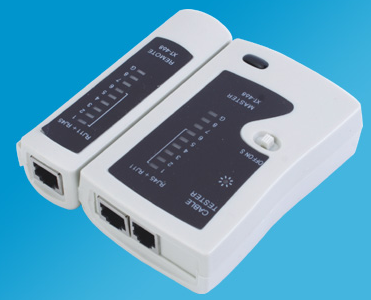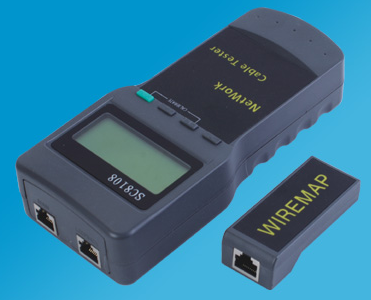
 Lan Cable
(29)
Lan Cable
(29)
 Patch Cord
(25)
Patch Cord
(25)
 Optic Fiber
(74)
Optic Fiber
(74)
 Networking Accessories
(424)
Networking Accessories
(424)
 Cable Management
(16)
Cable Management
(16)
 Networking Tools
(206)
Networking Tools
(206)
 Computer Cable
(434)
Computer Cable
(434)
 HDMI Cable
(424)
HDMI Cable
(424)
 USB Cable
(49)
USB Cable
(49)
 Computer Connector
(50)
Computer Connector
(50)
 Coaxial Cable
(1)
Coaxial Cable
(1)
 Alarm Cable
(30)
Alarm Cable
(30)
 Speaker Wire
(8)
Speaker Wire
(8)
 CCTV Accessories
(24)
CCTV Accessories
(24)
 Iphone Cable
(15)
Iphone Cable
(15)
 Computer Peripherals
(78)
Computer Peripherals
(78)
 New Products
(43)
New Products
(43)
Cable Tester


continuity tester is an item of electrical test equipment used to determine if an electrical path can be established between two points, that is if an electrical circuit can be made. The circuit under test is completely de-energized prior to connecting the apparatus.
The tester consists of an indicator in series with a source of electrical power - normally a battery, terminating in two test leads. If a complete circuit is established between the test-leads, the indicator is activated.
The indicator may be an electric light or a buzzer. This led to the term "buzzing out a circuit" (which means to test for continuity). Audible continuity buzzers or beepers are built into some models of multimeter.
For situations where continuity testing must be done on high resistance circuits, or where delicate conductors and sensitive components that might be damaged by excessive current are present, a low voltage, low current device must be used. These typically use an op-amp and watch batteries to drive an LED as an indicator. These testers can be exquisitely sensitive; for example they will indicate if the test points are taken by both hands.
There are times when a simple continuity test fails to reveal the problem. For example, vibration-induced problems in automobile wiring can be extremely difficult to detect because a short or open is not maintained long enough for a standard tester to respond.
In these applications a latching continuity tester is used. A more complex device, it detects intermittent opens and shorts as well as steady-state conditions. These devices contain a fast acting electronic switch (generally a Schmitt trigger) forming a gated astable oscillator which detects and locks (latches) the indicator on an intermittent condition with a duration of less than a millisecond.
PB005 Network Cable Tester
Functions:
1. Can test correspondingly double-twisted cables,1,2,3,4,5,6,7,8 and G, meanwhile, can judge wrong connection, short circuit and open circuit.
2. It can tests RJ11 and RJ45.

Test of double-twisted cables: switch on the power ( S is slow automatic, M is manual.) Put cables into both main tester and remote test. The lights of the main tester will turn on sequentially on 1 to G.
Main Tester: 1-2-3-4-5-6-7-8-G
Remote Tester: 1-2-3-4-5-6-7-8-G RJ45
1-2-3-4-5-6-------- RJ12
1-2-3-4------------- RJ11
Following are abnormal connections:
1. If one cable, for example cable No.3 is open circuited, the two No. 3 lights of the main tester and remote tester will not turn.
2. If several cables are not connected, several lights will not turn on respectively. If les than two cables are connected, none the lights is on.
3. If two ends of a cable is disordered, for example No.2 and No. 4, then displays on:
Main Tester: 1-2-3-4-5-6-7-8-G
Remote Tester: 1-4-3-2-5-6-7-8-G
4. If two cables are short circuited, neither of the corresponding lights is on of the remote tester while main tester remains unchanged. If three cables, including three, are short circuited, none of the corresponding lights is on.
PB012 Multi-Network Cable Tester
Not sure what's wrong with your network? Before you buy an expensive replacement router or cable modem, test your cables!
Network cable is a powerful special tool to prevent and solve cable installation problem. It is the best choice to verify any speech and data cable installation procedure. The tester is capable to have a number of tests such as cable connection sequence, length, user jumper and cable connection continuity and determine any open circuit, short circuit, jumper or cross-talk interference.If the wires are broken (and you know how those cables get snaked around the house) the tester will detect it. If you make your own patch cables and want to test that the wires are correctly assigned, then you need this! Test your twisted pair, Straight, Crossover, Cat 5 / Cat 5e / Cat 6 / UTP cables with RJ-11 or RJ-45 connectors. Insert the battery, turn on the tester, and connect one end of the cable to the Master side and the other end to the Remote side. The lights indicate problems (if any) with wires in the cables. A very useful item for the networking enthusiast!
Features:
One person enough to complete cable continuity check.
Check wiring error in 5E,6, coaxial cable and telephone line such as open circuit, short circuit, jumper wire, reverse connection or cross-talk interference.
Locate the wiring or connection error.
Measure cable length and determine the distance of open circuit and short circuit
Dynamically calibrate cable length and make length measurement as accurate as 97%
Simple and easy to use. Big screen to display test result clearly
Automatically time-delay shut off.
Measure length and pair with or without far-end recognizer.
Locate cable and there are 8 far-end passive test jacks
Far-end recognizer with promotion voice
Self-checking function and automatically compensate any change in capacity or ambient temperature.
Single board computer software watchdog design and reliable operation.
Powered by 4 AAA batteries.